engine YAMAHA R6 RACE 2022 Owners Manual
[x] Cancel search | Manufacturer: YAMAHA, Model Year: 2022, Model line: R6 RACE, Model: YAMAHA R6 RACE 2022Pages: 112, PDF Size: 4.06 MB
Page 6 of 112

Table of contentsSafety information ............................ 1-1
Description ....................................... 2-1
Left view ......................................... 2-1
Right view ....................................... 2-2
Controls and instruments ............... 2-3
Special features ............................... 3-1
D-mode (drive mode)...................... 3-1
Traction control system .................. 3-2
Quick shifter ................................... 3-4
Instrument an d control functions ... 4-1
Immobilizer system......................... 4-1
Main switch/steering lock............... 4-2
Handlebar switches ........................ 4-3
Indicator lights and warning
lights............................................ 4-5
Multi-function meter unit ................ 4-8
Clutch lever .................................. 4-16
Shift pedal .................................... 4-17
Brake lever.................................... 4-17
Brake pedal .................................. 4-17
ABS .............................................. 4-18
Fuel tank cap ................................ 4-19
Fuel ............................................... 4-19
Fuel tank overflow hose ............... 4-21
Catalytic converter ....................... 4-22
Seats ............................................ 4-22
Rear view mirrors.......................... 4-23
Adjusting the front fork ................. 4-24 Adjusting the shock absorber
assembly.................................... 4-26
EXUP system ................................ 4-28
Auxiliary DC connector ................. 4-29
Sidestand ...................................... 4-29
Ignition circuit cut-off system ....... 4-30
For your safety – pre-operation
checks ............................................... 5-1
Operation an d important ri din g
points ................................................. 6-1
Starting the engine .......................... 6-1
Shifting ............................................ 6-2
Engine break-in ............................... 6-3
Parking ............................................ 6-4
Perio dic maintenance an d
a d justment ........................................ 7-1
Tool kit ............................................ 7-2
Periodic maintenance charts .......... 7-3
Periodic maintenance chart for the emission control system .............. 7-3
General maintenance and lubrication chart ........................... 7-5
Removing and installing cowlings
and panels ................................... 7-9
Checking the spark plugs ............. 7-13
Canister ......................................... 7-14
Engine oil and oil filter cartridge.... 7-15
Why Yamalube .............................. 7-18 Coolant ......................................... 7-19
Air filter element ............................ 7-20
Checking the engine idling
speed ........................................ 7-20
Checking the throttle grip free
play ............................................ 7-21
Valve clearance............................. 7-21
Tires .............................................. 7-21
Cast wheels .................................. 7-24
Adjusting the clutch lever free play ............................................ 7-24
Checking the brake lever free play ............................................ 7-25
Brake light switches ..................... 7-26
Checking the front and rear
brake pads ................................ 7-26
Checking the brake fluid level ...... 7-27
Changing the brake fluid .............. 7-28
Drive chain slack........................... 7-29
Cleaning and lubricating the
drive chain ................................. 7-30
Checking and lubricating the cables ........................................ 7-31
Checking and lubricating the throttle grip and cable ............... 7-31
Checking and lubricating the
brake and shift pedals............... 7-32
Checking and lubricating the brake and clutch levers ............. 7-32
Checking and lubricating the sidestand................................... 7-33UBN6EBE0.book Page 1 Tuesday, October 19, 2021 8:35 AM
Page 9 of 112

Safety information
1-2
1
Many accidents involve inexperi-
enced operators. In fact, many op-
erators who have been involved in
accidents do not even have a cur-
rent motorcycle license.
• Make sure that you are qualified and that you only lend your mo-
torcycle to other qualified oper-
ators.
• Know your skills and limits. Staying within your limits may
help you to avoid an accident.
• We recommend that you prac- tice riding your motorcycle
where there is no traffic until you
have become thoroughly famil-
iar with the motorcycle and all of
its controls.
Many accidents have been
caused by error of the motorcycle
operator. A typical error made by
the operator is veering wide on a
turn due to excessive speed or un-
dercornering (insufficient lean an-
gle for the speed).
• Always obey the speed limit and never travel faster than warrant-
ed by road and traffic condi-
tions. • Always signal before turning or
changing lanes. Make sure that
other motorists can see you.
The posture of the operator is im-
portant for proper control.
The operator should keep both
hands on the handlebar and both
feet on the operator footrests dur-
ing operation to maintain control
of the motorcycle.
Never ride under the influence of
alcohol or other drugs.
This motorcycle is intended for
closed circuit use only. It is not
suitable for use on public roads.
Protective Apparel
The majority of fatalities from motorcy-
cle accidents are the result of head in-
juries. The use of a safety helmet is the
single most critical factor in the pre-
vention or reduction of head injuries. Always wear an approved helmet.
Wear a face shield or goggles.
Wind in your unprotected eyes
could contribute to an impairment
of vision that could delay seeing a
hazard.
The use of a jacket, heavy boots,
trousers, gloves, etc., is effective
in preventing or reducing abra-
sions or lacerations.
Never wear loose-fitting clothes,
otherwise they could catch on the
control levers, footrests, or wheels
and cause injury or an accident.
Always wear protective clothing
that covers your legs, ankles, and
feet. The engine or exhaust sys-
tem become very hot during or af-
ter operation and can cause
burns.
Avoi d Car bon Monoxi de Poisonin g
All engine exhaust contains carbon
monoxide, a deadly gas. Breathing
carbon monoxide can cause head-
aches, dizziness, drowsiness, nausea,
confusion, and eventually death.
Carbon Monoxide is a colorless, odor-
less, tasteless gas which may be pres-
ent even if you do not see or smell any
engine exhaust. Deadly levels of car-
bon monoxide can collect rapidly and
you can quickly be overcome and un-
able to save yourself. Also, deadly lev-
els of carbon monoxide can linger for
UBN6EBE0.book Page 2 Tuesday, October 19, 2021 8:35 AM
Page 10 of 112

Safety information
1-3
1hours or days in enclosed or poorly
ventilated areas. If you experience any
symptoms of carbon monoxide poi-
soning, leave the area immediately, get
fresh air, and SEEK MEDICAL TREAT-
MENT.
Do not run engine indoors. Even if
you try to ventilate engine exhaust
with fans or open windows and
doors, carbon monoxide can rap-
idly reach dangerous levels.
Do not run engine in poorly venti-
lated or partially enclosed areas
such as barns, garages, or car-
ports.
Do not run engine outdoors where
engine exhaust can be drawn into
a building through openings such
as windows and doors.
Loa din g
Adding accessories or cargo to your
motorcycle can adversely affect stabil-
ity and handling if the weight distribu-
tion of the motorcycle is changed. To
avoid the possibility of an accident, use
extreme caution when adding cargo or
accessories to your motorcycle. Use
extra care when riding a motorcycle that has added cargo or accessories.
Here, along with the information about
accessories below, are some general
guidelines to follow if loading cargo to
your motorcycle:
The total weight of the operator, ac-
cessories and cargo must not exceed
the maximum load limit.
Operation of
an overloa ded vehicle coul d cause
an acci dent.
When loading within this weight limit,
keep the following in mind: Cargo and accessory weight
should be kept as low and close to
the motorcycle as possible. Se-
curely pack your heaviest items as
close to the center of the vehicle
as possible and make sure to dis-
tribute the weight as evenly as
possible on both sides of the mo-
torcycle to minimize imbalance or
instability.
Shifting weights can create a sud-
den imbalance. Make sure that
accessories and cargo are se- curely attached to the motorcycle
before riding. Check accessory
mounts and cargo restraints fre-
quently.
• Properly adjust the suspension for your load (suspension-ad-
justable models only), and
check the condition and pres-
sure of your tires.
• Never attach any large or heavy items to the handlebar, front
fork, or front fender. These
items, including such cargo as
sleeping bags, duffel bags, or
tents, can create unstable han-
dling or a slow steering re-
sponse.
This vehicle is not desi gne d to
pull a trailer or to be attached to
a si decar.
Genuine Yamaha Accessories
Choosing accessories for your vehicle
is an important decision. Genuine
Yamaha accessories, which are avail- able only from a Yamaha dealer, have
been designed, tested, and approved
by Yamaha for use on your vehicle.
Maximum loa d:
185 kg (408 lb)
UBN6EBE0.book Page 3 Tuesday, October 19, 2021 8:35 AM
Page 11 of 112

Safety information
1-4
1
Many companies with no connection
to Yamaha manufacture parts and ac-
cessories or offer other modifications
for Yamaha vehicles. Yamaha is not in
a position to test the products that
these aftermarket companies produce.
Therefore, Yamaha can neither en-
dorse nor recommend the use of ac-
cessories not sold by Yamaha or
modifications not specifically recom-
mended by Yamaha, even if sold and
installed by a Yamaha dealer.
Aftermarket Parts, Accessories, an
d
Mo difications
While you may find aftermarket prod-
ucts similar in design and quality to
genuine Yamaha accessories, recog-
nize that some aftermarket accesso-
ries or modifications are not suitable
because of potential safety hazards to
you or others. Installing aftermarket
products or having other modifications
performed to your vehicle that change
any of the vehicle’s design or operation
characteristics can put you and others
at greater risk of serious injury or
death. You are responsible for injuries
related to changes in the vehicle. Keep the following guidelines in mind,
as well as those provided under “Load-
ing” when mounting accessories.
Never install accessories or carry
cargo that would impair the per-
formance of your motorcycle.
Carefully inspect the accessory
before using it to make sure that it
does not in any way reduce
ground clearance or cornering
clearance, limit suspension travel,
steering travel or control opera-
tion, or obscure lights or reflec-
tors.
• Accessories fitted to the han- dlebar or the front fork area can
create instability due to improp-
er weight distribution or aerody-
namic changes. If accessories
are added to the handlebar or
front fork area, they must be as
lightweight as possible and
should be kept to a minimum.
• Bulky or large accessories may seriously affect the stability of
the motorcycle due to aerody-
namic effects. Wind may at-
tempt to lift the motorcycle, or
the motorcycle may become unstable in cross winds. These
accessories may also cause in-
stability when passing or being
passed by large vehicles.
• Certain accessories can dis- place the operator from his or
her normal riding position. This
improper position limits the
freedom of movement of the
operator and may limit control
ability, therefore, such accesso-
ries are not recommended.
Use caution when adding electri-
cal accessories. If electrical ac-
cessories exceed the capacity of
the motorcycle’s electrical sys-
tem, an electric failure could re-
sult, which could cause a
dangerous loss of lights or engine
power.
Aftermarket Tires an d Rims
The tires and rims that came with your
motorcycle were designed to match
the performance capabilities and to
provide the best combination of han-
dling, braking, and comfort. Other
tires, rims, sizes, and combinations
may not be appropriate. See page 7-21
UBN6EBE0.book Page 4 Tuesday, October 19, 2021 8:35 AM
Page 13 of 112
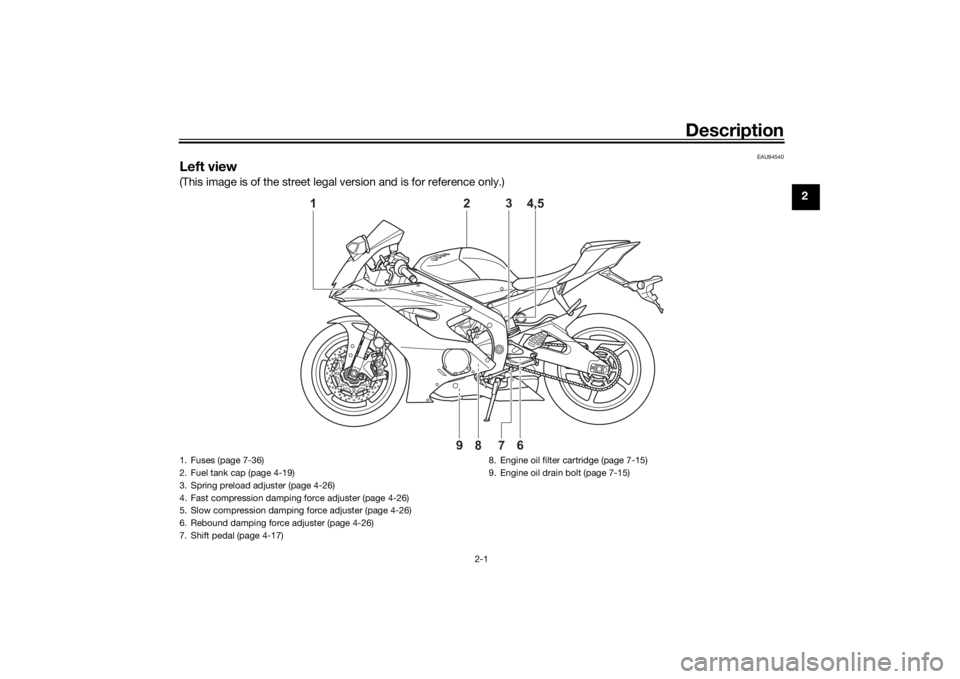
Description
2-1
2
EAU94540
Left view(This image is of the street legal version and is for reference only.)
16789
3 4,5
2
1. Fuses (page 7-36F
2. Fuel tank cap (page 4-19F
3. Spring preload adjuster (page 4-26F
4. Fast compression damping force adjuster (page 4-26F
5. Slow compression damping force adjuster (page 4-26F
6. Rebound damping force adjuster (page 4-26)
7. Shift pedal (page 4-17F
8. Engine oil filter cartridge (page 7-15F
9. Engine oil drain bolt (page 7-15F
UBN6EBE0.book Page 1 Tuesday, October 19, 2021 8:35 AM
Page 14 of 112
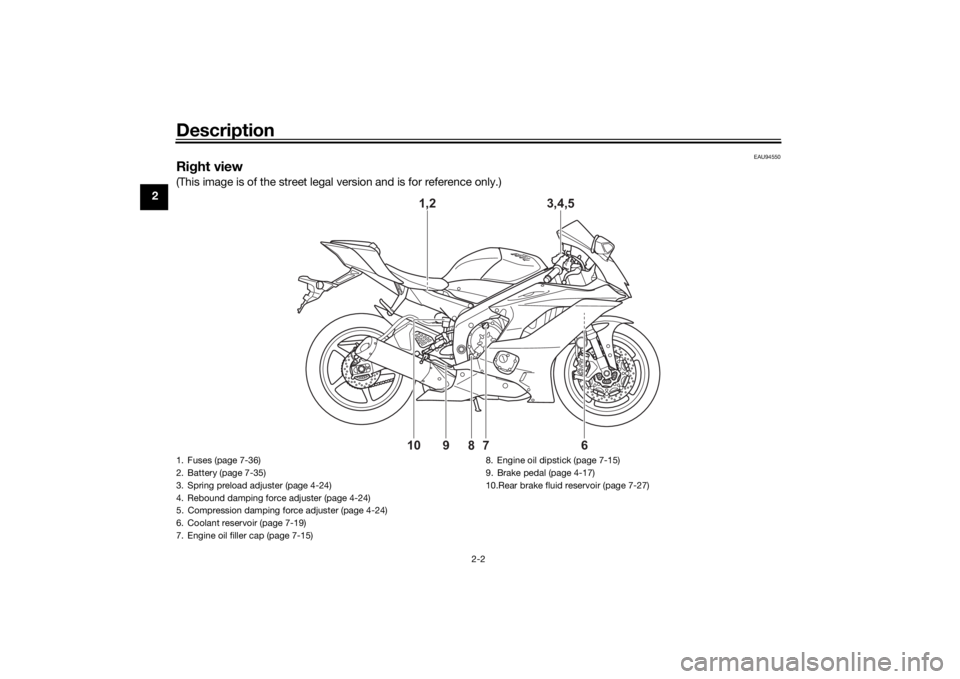
Description
2-2
2
EAU94550
Right view(This image is of the street legal version and is for reference only.)
1,2
3,4,5
6
8910 7
1. Fuses (page 7-36)
2. Battery (page 7-35)
3. Spring preload adjuster (page 4-24)
4. Rebound damping force adjuster (page 4-24)
5. Compression damping force adjuster (page 4-24)
6. Coolant reservoir (page 7-19)
7. Engine oil filler cap (page 7-15) 8. Engine oil dipstick (page 7-15)
9. Brake pedal (page 4-17)
10.Rear brake fluid reservoir (page 7-27)UBN6EBE0.book Page 2 Tuesday, October 19, 2021 8:35 AM
Page 16 of 112
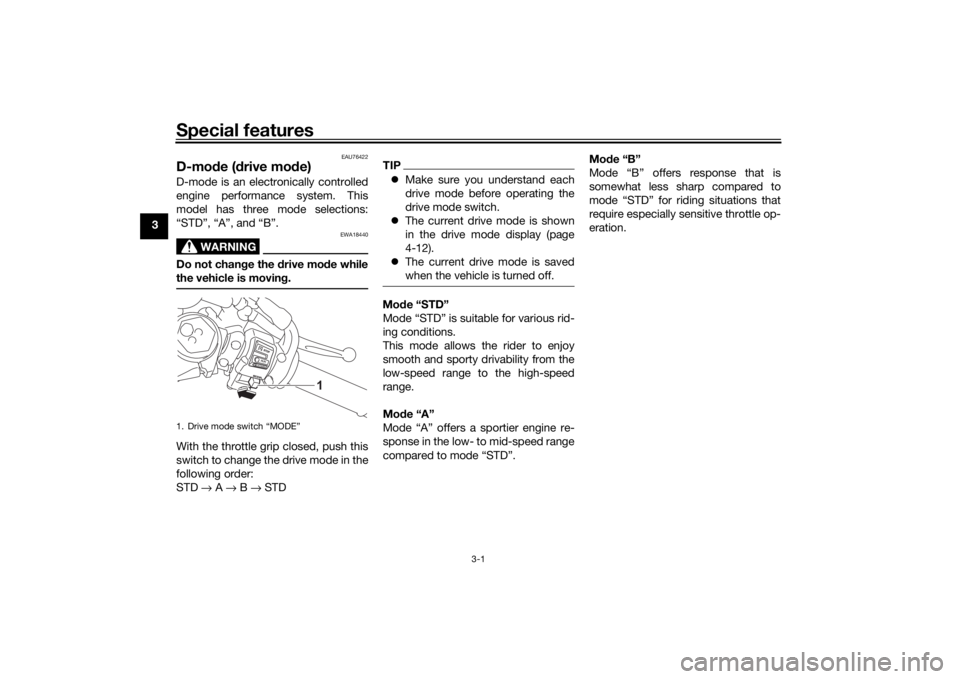
Special features
3-1
3
EAU76422
D-mode ( drive mo de)D-mode is an electronically controlled
engine performance system. This
model has three mode selections:
“STD”, “A”, and “B”.
WARNING
EWA18440
Do not chan ge the d rive mo de while
the vehicle is movin g.With the throttle grip closed, push this
switch to change the drive mode in the
following order:
STD → A → B → STD
TIP Make sure you understand each
drive mode before operating the
drive mode switch.
The current drive mode is shown
in the drive mode display (page
4-12).
The current drive mode is saved
when the vehicle is turned off.Mo de “STD”
Mode “STD” is suitable for various rid-
ing conditions.
This mode allows the rider to enjoy
smooth and sporty drivability from the
low-speed range to the high-speed
range.
Mo de “A”
Mode “A” offers a sportier engine re-
sponse in the low- to mid-speed range
compared to mode “STD”. Mo
de “B”
Mode “B” offers response that is
somewhat less sharp compared to
mode “STD” for riding situations that
require especially sensitive throttle op-
eration.
1. Drive mode switch “MODE”
1
UBN6EBE0.book Page 1 Tuesday, October 19, 2021 8:35 AM
Page 17 of 112
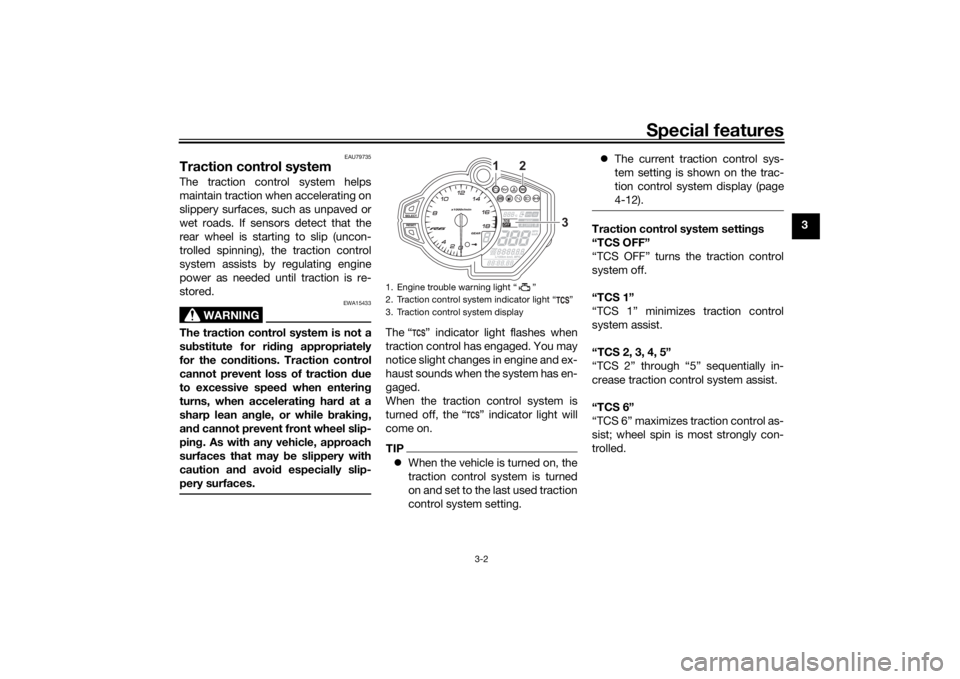
Special features
3-2
3
EAU79735
Traction control systemThe traction control system helps
maintain traction when accelerating on
slippery surfaces, such as unpaved or
wet roads. If sensors detect that the
rear wheel is starting to slip (uncon-
trolled spinning), the traction control
system assists by regulating engine
power as needed until traction is re-
stored.
WARNING
EWA15433
The traction control system is not a
substitute for ri din g appropriately
for the con ditions. Traction control
cannot prevent loss of traction d ue
to excessive spee d when enterin g
turns, when acceleratin g har d at a
sharp lean an gle, or while b raking,
an d cannot prevent front wheel slip-
pin g. As with any vehicle, approach
surfaces that may be slippery with
caution an d avoi d especially slip-
pery surfaces.
The “ ” indicator light flashes when
traction control has engaged. You may
notice slight changes in engine and ex-
haust sounds when the system has en-
gaged.
When the traction control system is
turned off, the “ ” indicator light will
come on.TIP When the vehicle is turned on, the
traction control system is turned
on and set to the last used traction
control system setting.
The current traction control sys-
tem setting is shown on the trac-
tion control system display (page
4-12).
Traction control system settin gs
“TCS OFF”
“TCS OFF” turns the traction control
system off.
“TCS 1”
“TCS 1” minimizes traction control
system assist.
“TCS 2, 3, 4, 5”
“TCS 2” through “5” sequentially in-
crease traction control system assist.
“TCS 6”
“TCS 6” maximizes traction control as-
sist; wheel spin is most strongly con-
trolled.
1. Engine trouble warning light “ ”
2. Traction control system indicator light “ ”
3. Traction control system display
12
3
UBN6EBE0.book Page 2 Tuesday, October 19, 2021 8:35 AM
Page 19 of 112
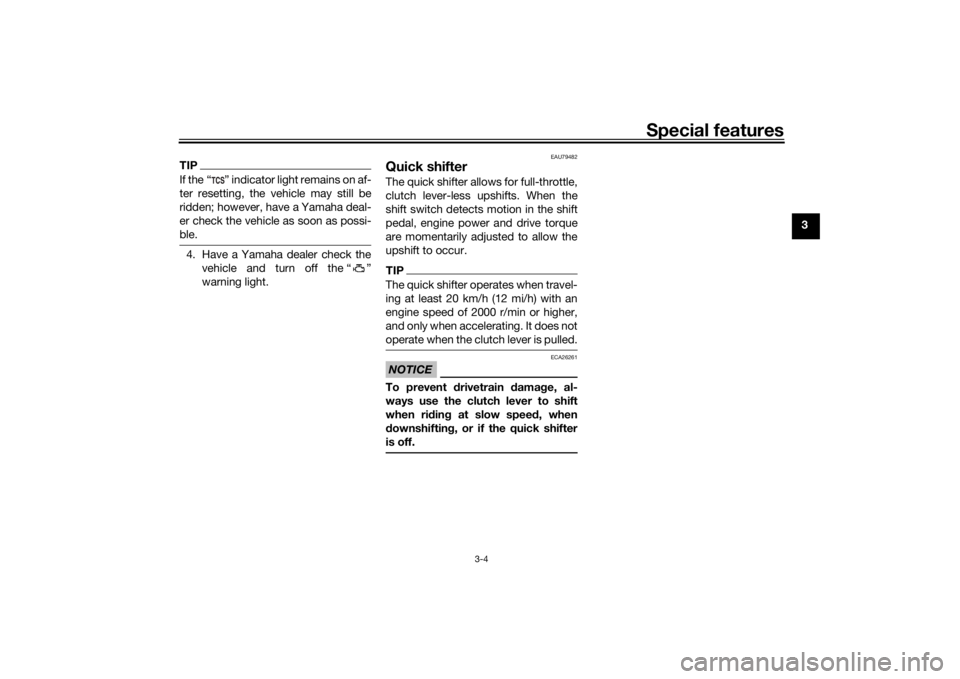
Special features
3-4
3
TIPIf the “ ” indicator light remains on af-
ter resetting, the vehicle may still be
ridden; however, have a Yamaha deal-
er check the vehicle as soon as possi-
ble.4. Have a Yamaha dealer check thevehicle and turn off the “ ”
warning light.
EAU79482
Quick shifterThe quick shifter allows for full-throttle,
clutch lever-less upshifts. When the
shift switch detects motion in the shift
pedal, engine power and drive torque
are momentarily adjusted to allow the
upshift to occur.TIPThe quick shifter operates when travel-
ing at least 20 km/h (12 mi/h) with an
engine speed of 2000 r/min or higher,
and only when accelerating. It does not
operate when the clutch lever is pulled.NOTICE
ECA26261
To prevent d rivetrain damag e, al-
ways use the clutch lever to shift
when rid ing at slow speed , when
d ownshiftin g, or if the quick shifter
is off.
UBN6EBE0.book Page 4 Tuesday, October 19, 2021 8:35 AM
Page 21 of 112
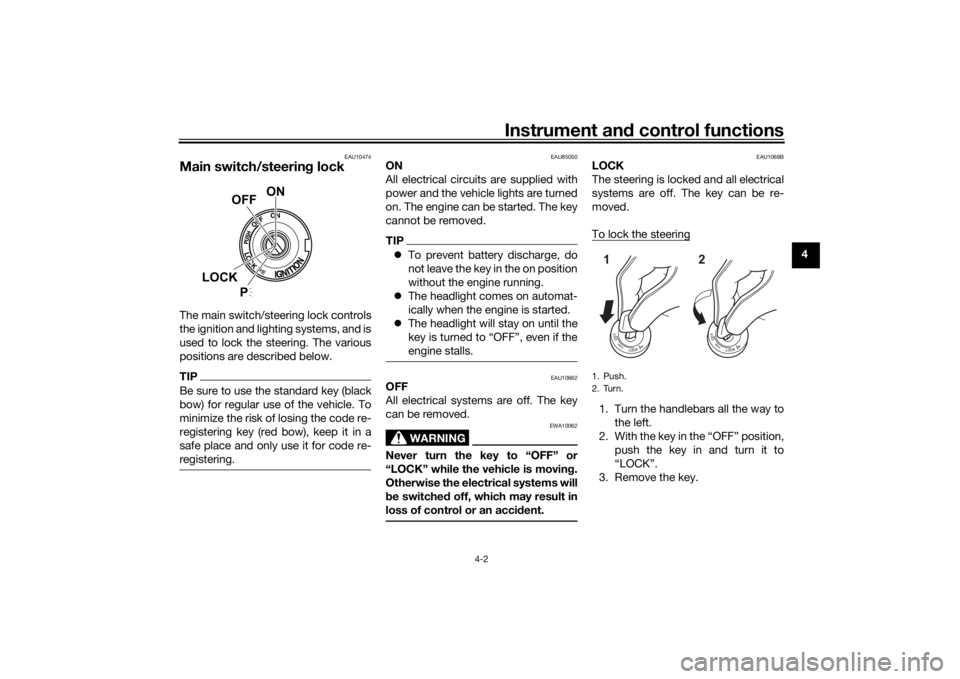
Instrument and control functions
4-2
4
EAU10474
Main switch/steerin g lockThe main switch/steering lock controls
the ignition and lighting systems, and is
used to lock the steering. The various
positions are described below.TIPBe sure to use the standard key (black
bow) for regular use of the vehicle. To
minimize the risk of losing the code re-
registering key (red bow), keep it in a
safe place and only use it for code re-
registering.
EAU85050
ON
All electrical circuits are supplied with
power and the vehicle lights are turned
on. The engine can be started. The key
cannot be removed.TIP To prevent battery discharge, do
not leave the key in the on position
without the engine running.
The headlight comes on automat-
ically when the engine is started.
The headlight will stay on until the
key is turned to “OFF”, even if the
engine stalls.
EAU10662
OFF
All electrical systems are off. The key
can be removed.
WARNING
EWA10062
Never turn the key to “OFF” or
“LOCK” while the vehicle is movin g.
Otherwise the electrical systems will
b e switched off, which may result in
loss of control or an acci dent.
EAU1068B
LOCK
The steering is locked and all electrical
systems are off. The key can be re-
moved.
To lock the steering1. Turn the handlebars all the way to
the left.
2. With the key in the “OFF” position, push the key in and turn it to
“LOCK”.
3. Remove the key.
ON
OFF
LOCK
P
1. PushK
2. TurnK12
UBN6EBE0.book Page 2 Tuesday, October 19, 2021 8:35 AM